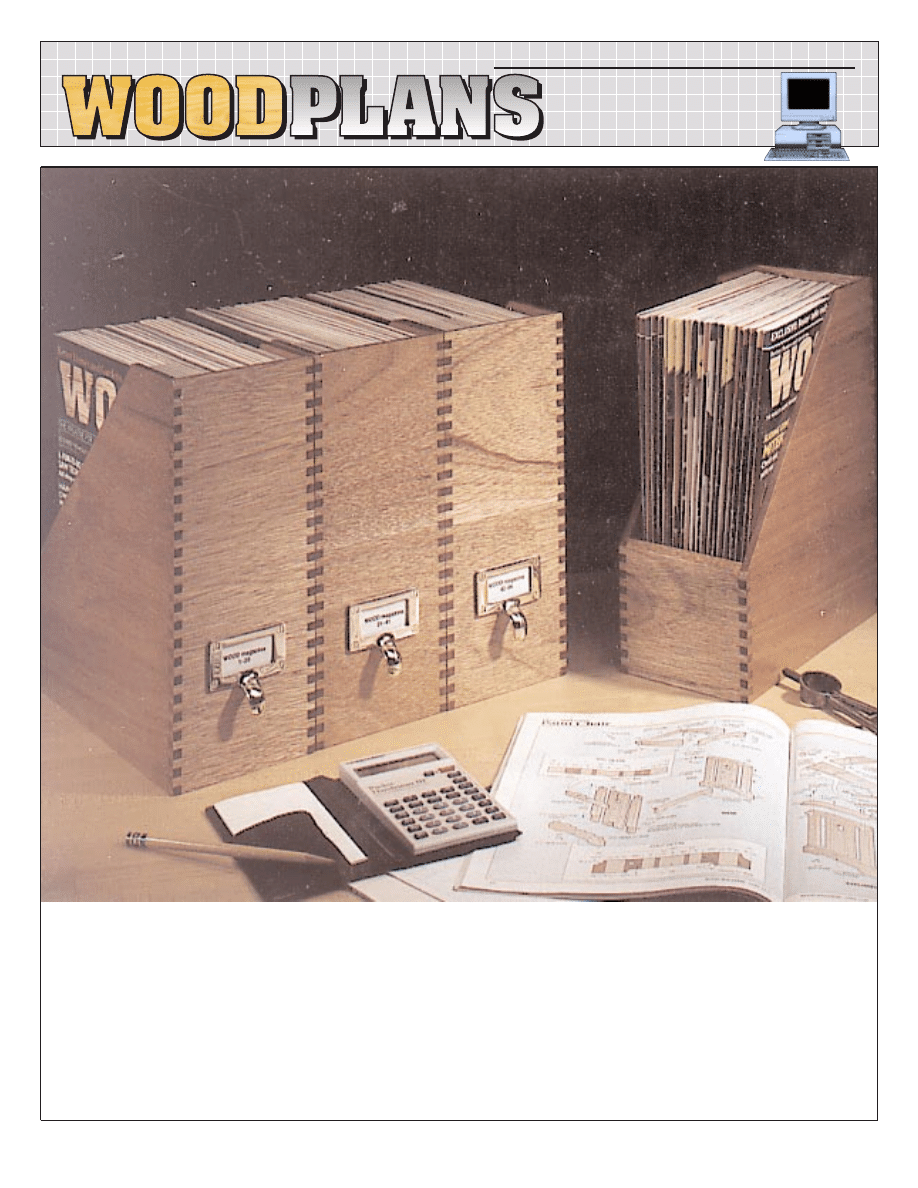
http://www.woodonline.com
DOWNLOADABLE
ONLINE WOODWORKING PLANS
®
Page 1 of 12
DP-00332
©Copyright Meredith Corporation 1998
It’s a Keeper
Neat, orderly
storage for your
WOOD
®
magazines
Do you keep back issues of
WOOD magazine for reference? And, if you haven’t
noticed, starting with issue 153
WOOD magazine not only got thicker, but wider and
taller. To house both the past issues of
WOOD magazine and the newly upsized
version, build these handsome and handy magazine file boxes. These boxes are as
good looking as they are durable, and they’re dimensioned to fit both sizes of
magazines. Included with the box designs are the box-joint jig plan and procedure to
machine this strong and decorative joinery.
Neat, orderly
storage for your
WOOD
®
magazines
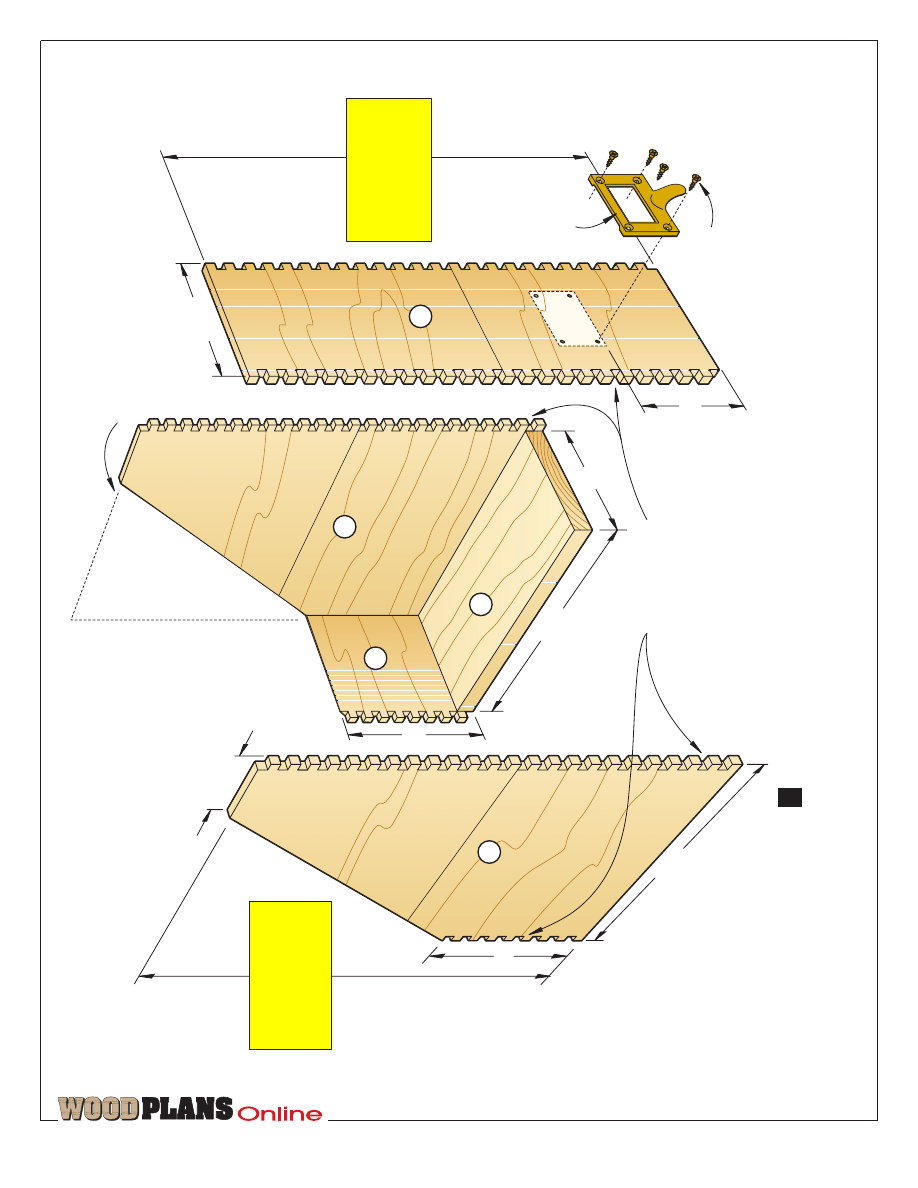
TM
Page 2 of 12
4"
‹" box joints
on all corners
4"
Saw off corner after assembly.
8fl"
2fi"
3Œ"
9¤"
Brass
card pull
#6 x ›" F.H.
brass wood screw
2fi"
4fi"
B
D
C
A
A
NOTE:
Rip parts A, B, and C to final
width after cutting box joints.
11fl" for issues
153 on, large box
11¤" for issues
1-152, small box
11fl" for issues
153 on, large box
11¤" for issues
1-152, small box
1
EXPLODED VIEW
Viewed from backside
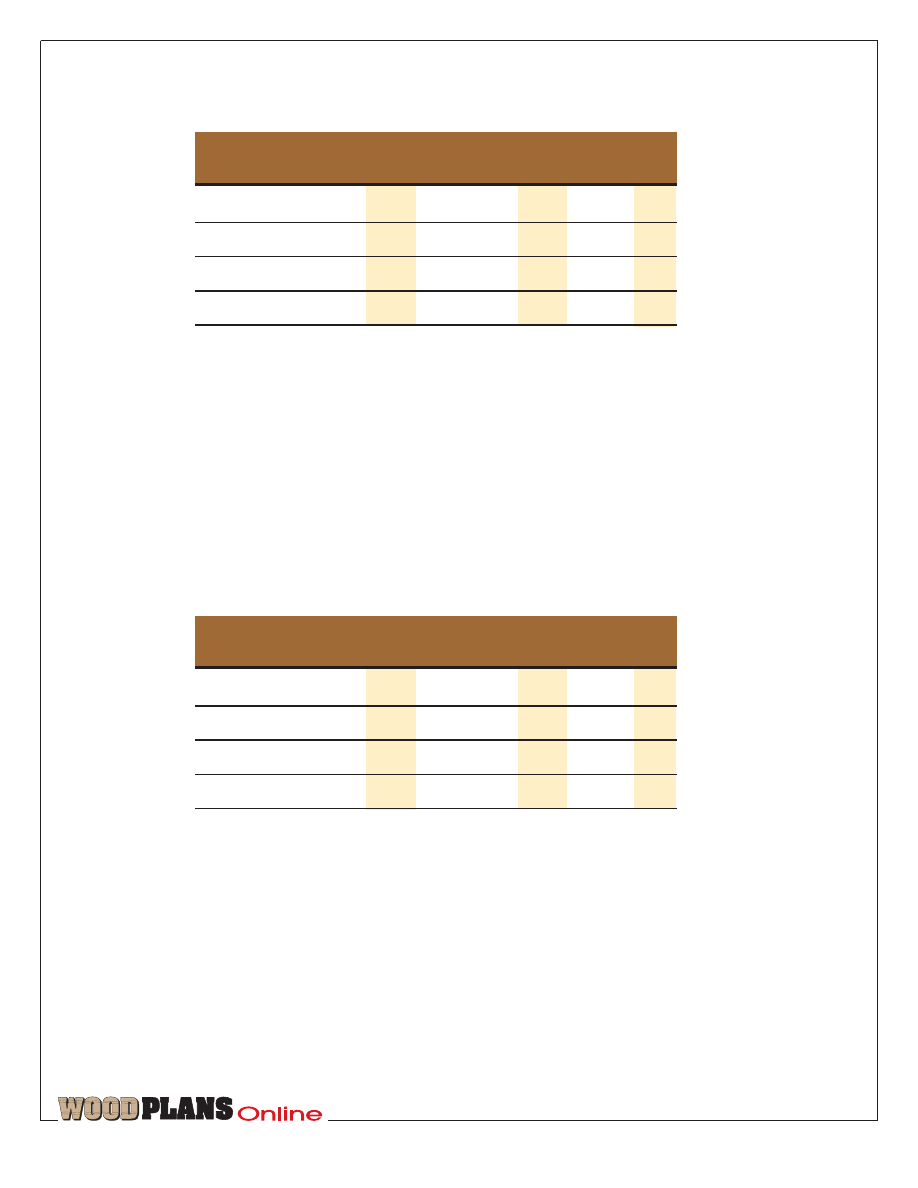
TM
Page 3 of 12
Materials List, Small Box
FINISHED SIZE
Part
T
W
L Matl. Qty.
A* sides
‹"
11¤"
9¤"
M
2
B* back
‹"
11¤"
4fi"
M
1
C* front
‹"
4"
4fi"
M
1
D bottom
fi"
4"
8fl"
M
1
*Parts initially cut oversize. See the instructions.
Material key:
M–mahogany.
Supplies:
Drawer pull with card holder, semigloss clear
lacquer.
Sources:
Card pull:
Solid brass card pull, no. 70763, $9.49 each.
Call Rockler, 800/279-4441, or go to rockler.com.
Materials List, Large Box
FINISHED SIZE
Part
T
W
L Matl. Qty.
A* sides
‹"
11fl"
9¤"
M
2
B* back
‹"
11fl"
4fi"
M
1
C* front
‹"
4"
4fi"
M
1
D bottom
fi"
4"
8fl"
M
1
*Parts initially cut oversize. See the instructions.
Material key:
M–mahogany.
Supplies:
Drawer pull with card holder, semigloss clear
lacquer.
Sources:
Card pull:
Solid brass card pull, no. 70763, $9.49 each.
Call Rockler, 800/279-4441, or go to rockler.com.
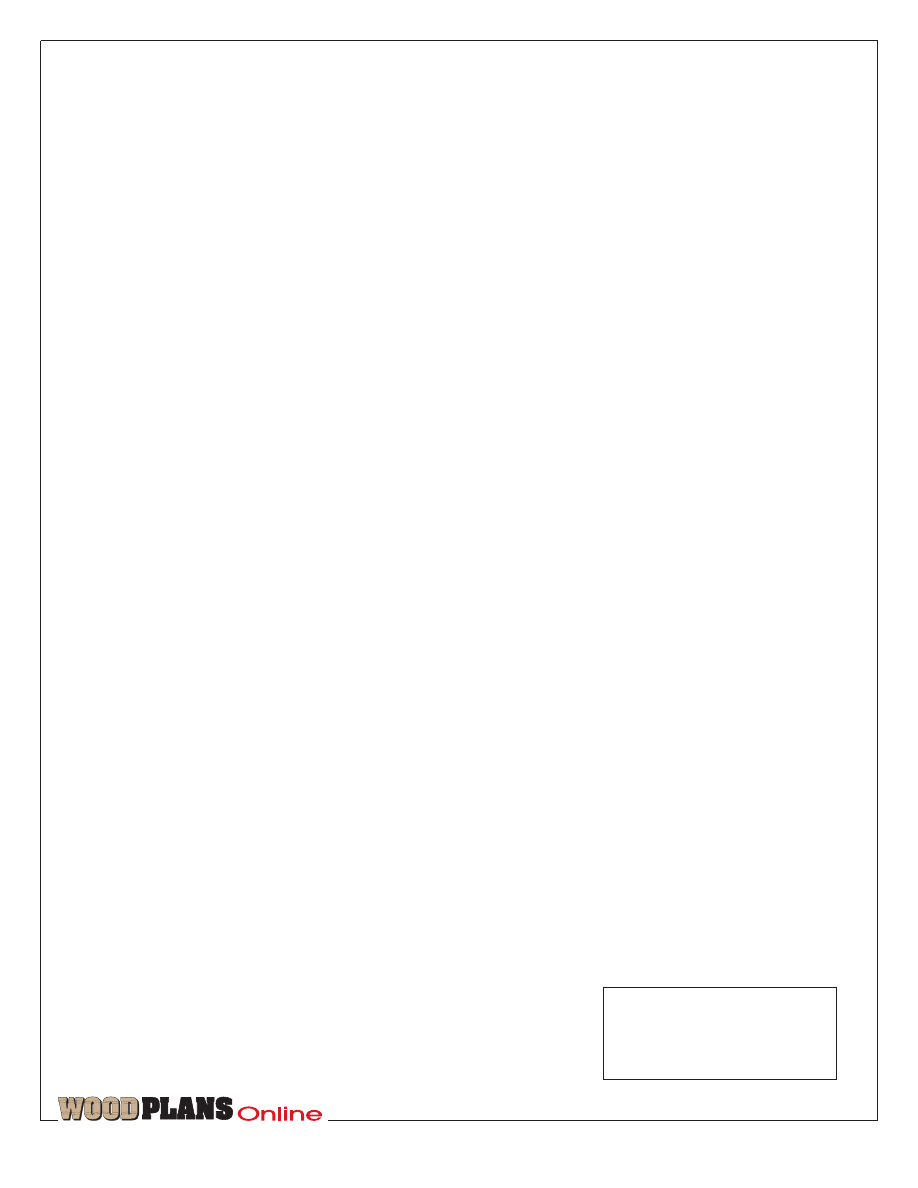
TM
Page 4 of 12
Rustle up some thin stock
The magazine file calls for ‹"-
thick stock 11fi" wide for the
small box, or 12" wide for the
large box. You could construct
the file of plywood. But if you
want to use solid mahogany as
we did, here’s how.
1
Joint one edge of a ‡
×
6
×
30"
piece of mahogany. Resaw it into
two ›"-thick pieces.
2
Edge-glue the two resulting
pieces along the jointed edges,
both sawn surfaces facing up.
(This is called book-matching.)
3
Plane the book-matched stock
to ‹" thick. Plane several pieces
of scrapwood to the same
thickness for setting up the box-
joint jig later.
4
Rip the piece to 11fi" for the
small box, or 12" for the large
box. Refer to the Materials List,
and cut parts A, B, and C to
finished length plus „". (The
extra length allows you to make
the joint fingers Î" longer. You
then can sand the joints flush
after assembly.) Leave the parts
overwidth for now. Mark a
bottom edge on each piece.
Tackle the box joints next
1
Refer to the article beginning on
page 5 for instructions on building
and using our box-joint jig.
2
Install a ‹" dado blade on your
tablesaw. Adjust the saw’s cutting
depth to Ç".
3
Install the jig’s ‹" indexing pin.
(If you’re cutting the box joints
with another type of jig, install it
and set it up for ‹" fingers Ç"
long, following applicable
instructions.)
4
Saw fingers in two pieces of
scrapwood, and test the joint for
fit. Adjust and retest as necessary.
5
With the jig properly adjusted,
saw fingers on both ends of parts
A, B, and C, starting with a finger
at the bottom of each side (A) and
mating fingers on parts B and C.
6
Rip the sides (A) and back (B) to
finished width, sawing the waste
off the top edge. (For appearance,
you could make the parts slightly
wider if necssary to avoid cutting
through a finger.) Cut the front
(C) to the same width as A and B,
but not to the finished width
shown. Sand the inside faces.
Build the box, cut a corner
1
From scrapwood, cut four
clamping cauls, two that measure
‡
×
7‡
×
11‹" and two that are
‡
×
2‡
×
11‹" for the small box or
two that measure ‡
×
7‡
×
12" and
two that are ‡
×
2‡
×
12" for the
large box.
2
Cut the bottom (D) to the
dimensions shown in the
Materials List. Dry-assemble parts
A, B, C, and D to check fit.
3
Apply white glue to the inside
edges of each joint finger, using a
small brush. (White glue’s longer
open time allows you to glue and
assemble all the joints before it
starts to dry.) Apply glue along the
edges and ends of the bottom.
4
Assemble the file box. Position
the clamping cauls on the sides
and ends, and clamp the assembly
with band clamps. (We used
three.) Ensure that the bottom is
flush and the joints are tight.
Clamp until the glue dries. Sand
the joints flush.
5
Lay out the angled cutting line
on one side of the file box.
Bandsaw the angle, cutting with a
fine-toothed blade. (To minimize
chip-out, apply wide masking tape
along the cutting line on the
inside of the side that will be up
when you saw and the outside of
the one that will be on the
bottom.) Plane or sand the sawn
edge smooth and straight.
6
Finish-sand the box, using
progressively finer sandpaper
from 150- to 320-grit. Sand
slight round-overs on the
opening’s edges.
7
Apply a clear finish. (We
sprayed on several coats of
semigloss lacquer, sanding
between coats.)
8
Attach a brass file handle where
shown. Poke screw pilot holes
with an awl. (We installed a brass
card holder with pull.) ¿
Produced by Marlen Kemmet
Written by Marlen Kemmet
Project design: Gary Webster
Graphic design: Lorna Johnson
Illustrations: Kim Downing; Lorna Johnson
Photographs: Marty Baldwin
©Copyright Meredith Corporation 1998
The purchase of these plans does not
transfer any copyright or other ownership
interest in the plans, the design, or the
finished project to the buyer. Buyer may
neither reproduce the plans for sale nor offer
for sale any copies of the finished project.
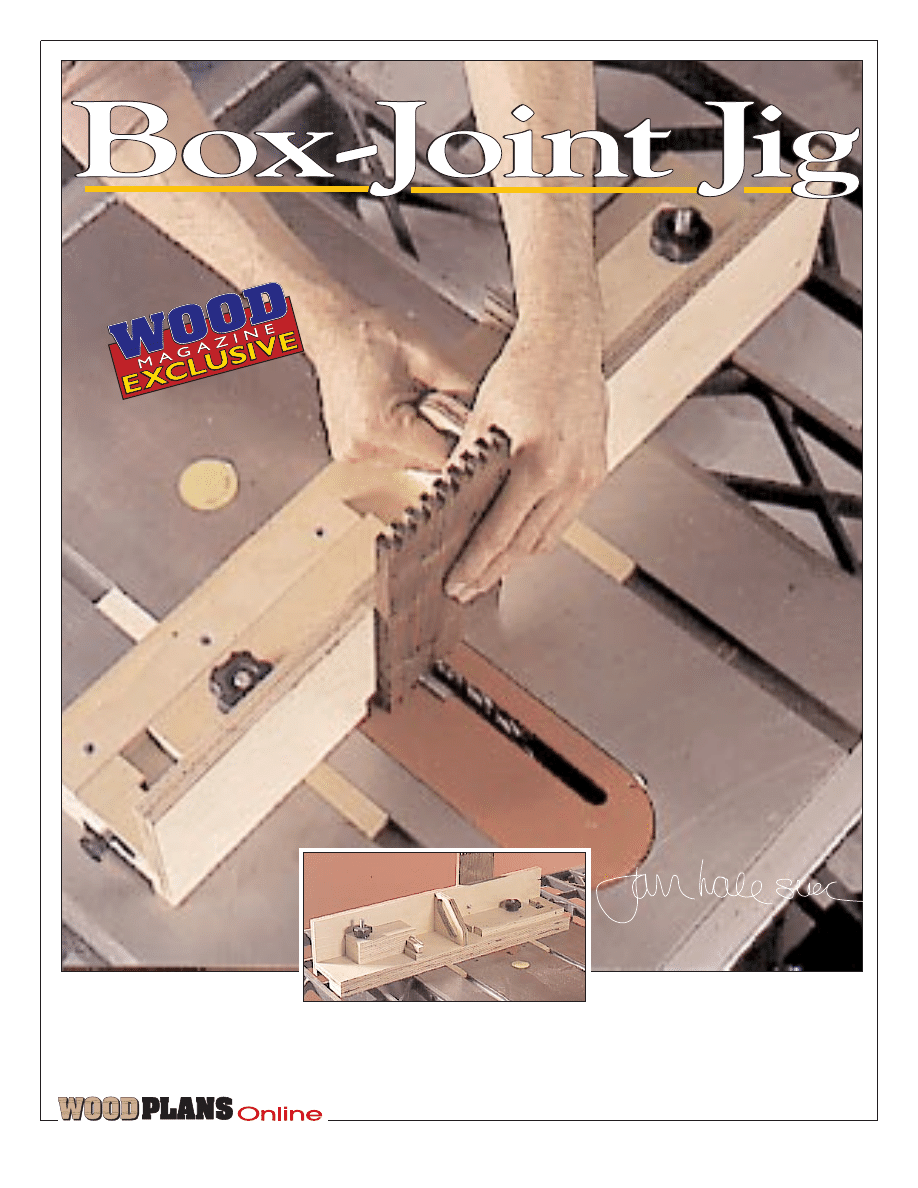
TM
Page 5 of 12
I’ve always liked box
joints, and here’s why.
They offer both strength
and unique good looks.
Although not as refined
as dovetail joints, they
can be cut on a tablesaw
or router table using a
simple shop-built jig. Not
only that, but I can use a
box-joint jig on virtually
any width or thickness of
stock. Our jig combines
simplicity of construction
with micro-adjustability.
Interchangeable indexing
pins allow you to cut box
joints of any size without
having to build a different
jig each time.
Jan Hale Svec
Assistant Design Editor
A
View from
back side of jig
I’ve always liked box
joints, and here’s why.
They offer both strength
and unique good looks.
Although not as refined
as dovetail joints, they
can be cut on a tablesaw
or router table using a
simple shop-built jig. Not
only that, but I can use a
box-joint jig on virtually
any width or thickness of
stock. Our jig combines
simplicity of construction
with micro-adjustability.
Interchangeable indexing
pins allow you to cut box
joints of any size without
having to build a different
jig each time.
Jan Hale Svec
Assistant Design Editor
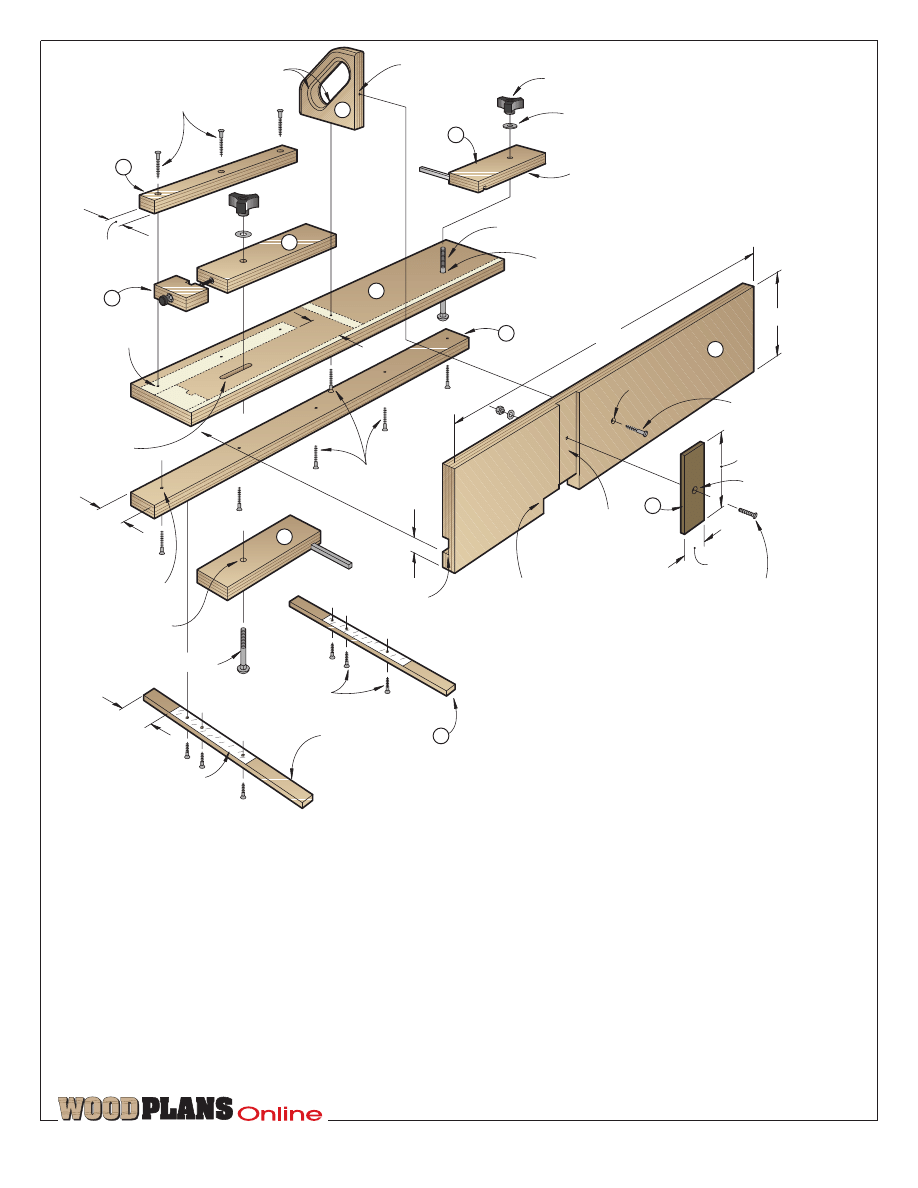
Indexing blocks stack on top of each
other, and store on the back side of jig.
Knob
3
/
8
" flat washer
3
/
8
" carriage bolt 4
1
/
2
" long
13
/
32
" hole
1
/
8
" round-overs
7
/
64
" pilot hole
1
/
2
" deep
#8 x 1
1
/
4
" F.H. wood screws
1
1
/
4
"
2
1
/
8
"
26"
*
* groove
3
/
8
" deep
13
/
32
" hole
3
/
8
" carriage bolt
Miter-gauge guides
7
/
16
" slot
2
1
/
8
" long
#8 x 1
1
/
4
" F.H.
wood screws
#8 x 1
1
/
4
" F.H.
wood screw
7
/
64
" pilot hole
1
/
2
" deep
5
/
32
" hole,
countersunk
on bottom side
EXPLODED VIEW
5
1
/
2
"
3
/
4
" notch 3
1
/
2
" long
1
3
/
4
" dado
1
/
4
" deep
*Actual thickness of
3
/
4
" plywood
7
/
32
" hole,
countersunk
5
1
/
2
"
1
3
/
4
"
#8 x
3
/
4
" F.H.
wood screws
5
/
32
" hole,
countersunk
2
1
/
2
"
2
1
/
4
"
Double-faced tape
C
I
A
I
B
D
H
E
F
G
J
10-24 F.H. machine screw
1" long with mating washer and nut
3" long
TM
Page 6 of 12
Let’s start with
the fence assembly
1
Cut the jig fence (A) to the size
listed in the Bill of Materials and
shown on the Parts View
drawing on page 9. (Due to its
stability, strength, and lack of
voids we used ‡" [18mm actual]
Baltic birch plywood.)
2
Mark the location, and cut the
‡
×
3fi" notch along the bottom of
the fence (A) where dimensioned
on the Parts View drawing. Then,
mark the location, and cut the 1‡"
dado ‹" deep in the front face of the
fence.
3
Measure the exact thickness
of your plywood, and cut a
groove along the back side of
the fence (A) where shown on
the Parts View and Exploded
View drawings. The groove
should be as wide as your
plywood is thick. And, the
groove should be up from the
bottom edge of your plywood a
distance equal to the thickness
of your plywood.
4
Mark the centerpoint, and drill
and countersink a ¸" hole
through the fence for attaching
the handle (E) later. Mark light
lines on the back side of the
fence for positioning the handle
onto the fence later.
5
Cut the backing plate (B) to
size. The backing plate is used
to minimize chipout when
using the jig. You’ll need one
backing plate for each size of
finger joint you’ll be cutting.
The plate should fit snug, yet
slide in the 1‡" dado in the
front face of the fence. Drill a
˛" mounting hole through the
backing plate and into the
fence. Screw the plate to the
fence.
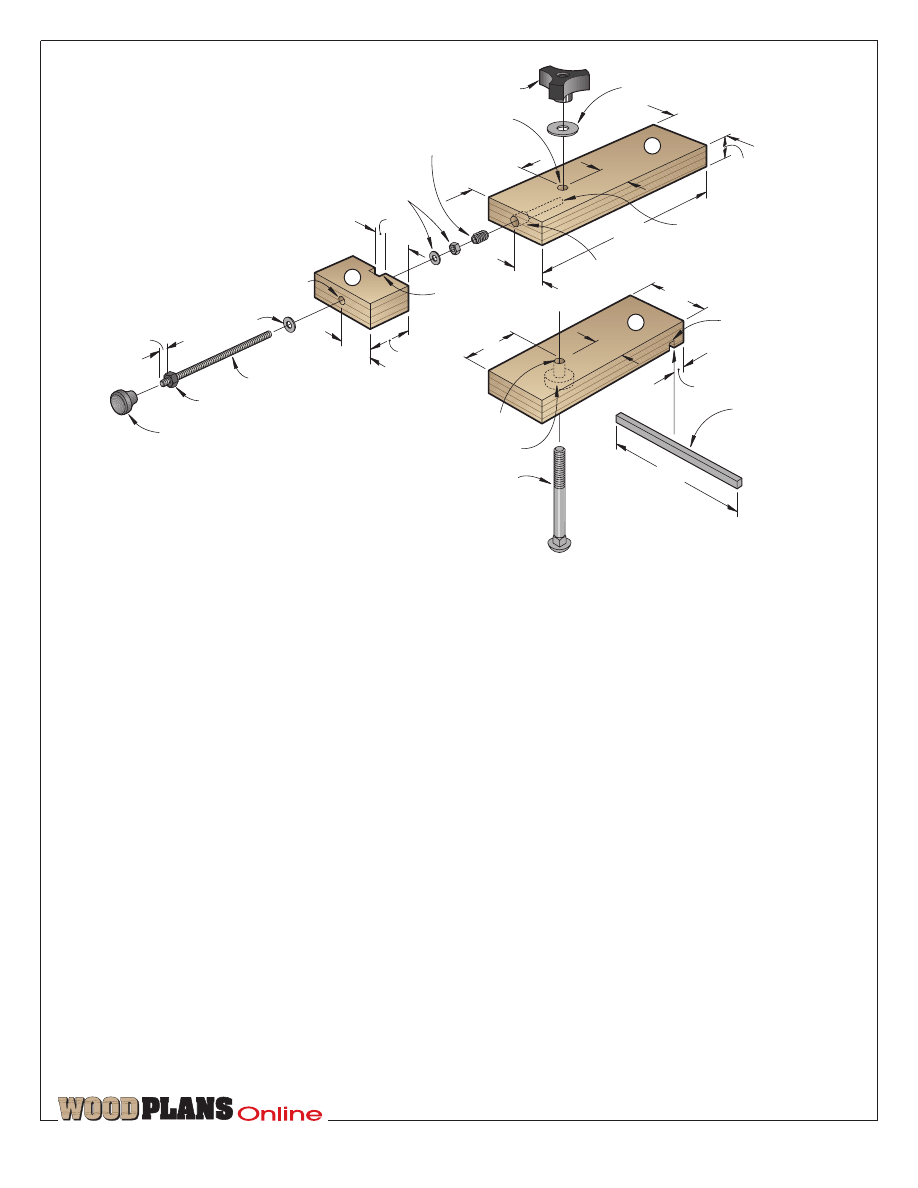
Plastic knob
3
/
8
" flat washer
2
1
/
2
"
2
1
/
2
"
8
1
/
4
"
1
1
/
4
"
2
1
/
4
"
1
1
/
4
"
10-32 all-thread rod
4" long
9
/
32
" hole
1
/
2
" deep
7
/
32
" hole
2" deep
10-32 threaded insert
#10 lock nut
and flat washer
1
/
2
"
1"
1
/
2
" notch
1
/
4
" deep
#10 flat washer
7
/
32
" hole
1
1
/
2
"
13
/
32
" hole
1" counterbore
1
/
4
" deep
3
/
8
" carriage bolt 3" long
Plastic knob with #10 threads
inside knob. Epoxy the knob
to the all-thread rod.
Indexing pin
(key stock)
1
/
4
x
1
/
4
x 4
1
/
2
"
long (Make
different sizes
as required for
box joints.)
1
/
4
" dado
1
/
4
" deep
(sized to fit
indexing pin)
1
/
2
"
1
1
/
4
"
1"
3
/
8
" hole
ADJUSTMENT ASSEMBLY
1
1
/
4
"
4
1
/
2
"
3
/
4
"
1
/
2
"
#10 lock nut
H
I
G
TM
Page 7 of 12
Add the base
assembly for stability
1
Cut the plywood jig base (C) to
the size listed in the Bill of
Materials and dimensioned on
the Parts View drawing.
2
Mark the location and cut the
Á" slot in the base where shown
on the Parts View. Then, mark
the centerpoint, and drill the
Â" hole through the base.
3
Cut the base support (D) to
size. Using the dimensions on
the Parts View, locate the hole
centerpoints, and drill the five
countersunk holes in the
support. With the back edges
and ends flush, glue and screw
D to C. Make sure the
screwheads don’t protrude
below the support and scratch
your tablesaw top later.
4
Glue the fence (A) to the
front edge of the base (C),
keeping the ends flush. Check
that the fence is square to the
base. This is important for
accurate cuts later.
5
Transfer the full-size handle (E)
pattern on page 10 to your
stock, and cut the handle to
shape. Rout ¤" round-overs on the
handle where noted on the
Exploded View drawing. Drill a
mounting hole through the bottom
of the base (C), and glue and screw
the handle to parts A and C.
For perfectly placed fingers,
add the adjustment block
Note: The distance between the
dado blade and the indexing
pin has to be equal to the width
of the slot the dado blade will
cut. This will ensure that the
fingers and notches are exactly
the same size and that the
mating pieces fit together
correctly. The adjustment block
assembly allows you to adjust
the distance between the blade
and indexing pin to achieve a
perfect fit of the box joints.
1
Cut the adjustment block
guide (F), adjustment block (G),
and index slide (H) to size.
2
Cut the fi" notch in the
adjustment block (G) where
shown on the Parts View
drawing. Then, drill a ˛" hole
through the center of the
notch. Glue the block to the
base (C), flush with the back
face of the fence (A) and flush
with the end of the base where
shown on the pattern.
3
Drill the holes in the index
slide (H) where shown on the
Adjustment Assembly drawing
and pattern insert. Drive a 10-32
threaded into the Ç"
counterbore, centered in the
end of the index slide.
4
Using the index slide (H) and
adjustment block (G) as spacers,
screw the adjustment block guide
(F) in place. The index slide
should slide between the guide
and fence (A) without slop.
5
Secure the adjustment block
(G) and index slide (H) together
with a 10-32 all-thread rod 4"
long, locknuts, washers, and a
plastic knob in the configuration
shown on the Adjustment
Assembly and Parts View drawings.
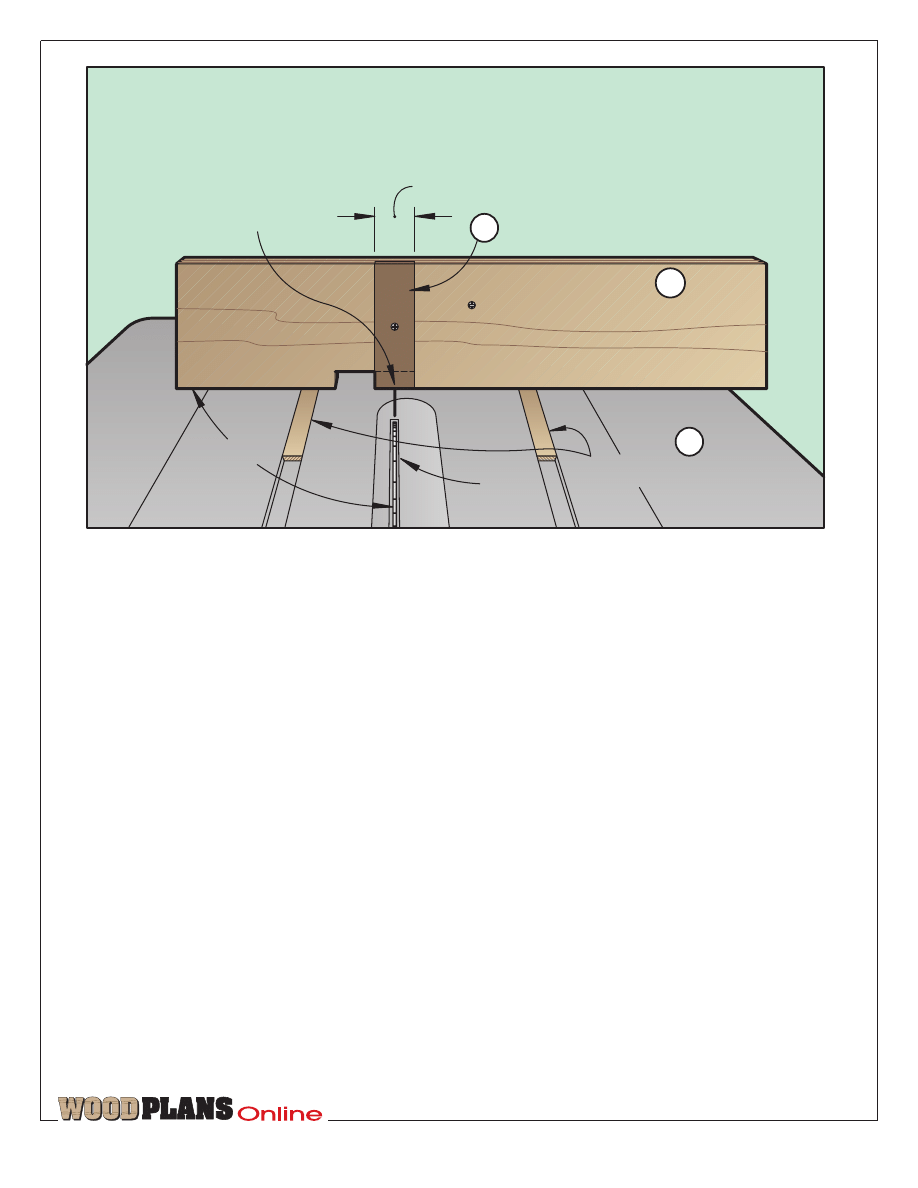
TM
Page 8 of 12
1
3
/
4
"
Saw
blade
Backing plate
Center the jig so the
backing plate centers
over the saw blade.
Fence
90
°
J
POSITIONING THE MITER-GAUGE GUIDES
Miter-gauge guides
B
A
Let’s form the indexing blocks
for different sized fingers
1
Cut the indexing blocks (I) to
size. Cut extras depending on
how many sizes of box joints you
wish to cut. We recommend four
(¤", ‹", fi", and ‡"). Drill a Â"
hole with a 1" counterbore ‹"
deep on the bottom side of each
block where located on the
Adjustment Assembly drawing.
2
For a ‹"-wide index pin, fit
your tablesaw with a ‹"-wide
dado blade, and cut a ‹" dado ‹"
deep located fi" in from the end
of the index block. Be careful to
keep the dado perpendicular to
the front edge of the indexing
block. where shown on the
Adjustment Assembly drawing.
3
From ‹" key stock, crosscut
an index bar 4fi" long, and
epoxy it into the ‹"-wide dado,
keeping the back end of the key
stock flush with the back edge of
the indexing block.
4
Repeat steps 2 and 3, keeping
the dadoes fi" from the end for
the other sizes of indexing pins.
We used metal key stock (used to
secure pulleys to spindles) for the
¤" and ‹" pins and Baltic birch
plywood for the fi" and ‡" pins.
5
Secure an indexing block (I) to
the bottom side of the base with
a 3"-long carriage bolt as shown
on the Exploded View drawing.
When the index blocks are not
being used, you can secure them
to the top side of the base where
shown on the same drawing.
Attach the miter-gauge
guides, and add the finish
1
Cut the miter-gauge guides (J)
to size according to the width
and depth of the miter-gauge
slots in your tablesaw. The
thickness should be „" less than
the depth of your miter-gauge
slots. Test-fit the miter-gauge
guides in the tablesaw slots.
Then, using thin strips of plastic
or wood, shim the guides in the
miter-gauge slots so the top
surface of each guide protrudes
just above the surface of your
tablesaw. Doing this keeps the
bottom surface of the jig from
rubbing on the tablesaw top.
2
Mark a line on each guide 2‹"
from the back end. Then, adhere a
5"-long piece of double-faced tape
to each guide starting at the line
just marked. See the Exploded
View drawing for reference.
3
As shown in the drawing
above, position the jig assembly
onto the guides, being careful to
keep the jig square to the blade.
Press down firmly to adhere the
tape-covered guides to the
bottom of the jig assembly.
4
Turn the base assembly over,
and drill and countersink six
mounting holes through the
guides and into the bottom of
the jig base (C). Leaving the
double-faced tape between the
guides and base, screw the
guides to the base bottom with
#8
×
‡" flathead wood screws.
5
Remove the hardware, then
finish-sand all the wood pieces.
Apply a clear finish to the parts
to seal the parts and keep them
clean over time. Reattach the
hardware and reassemble the jig.
6
If you used solid stock for the
miter-gauge guides (J), apply a
bit of paraffin wax to the sides
and bottom of the two guides for
easier sliding of the guides in the
tablesaw miter-gauge grooves.
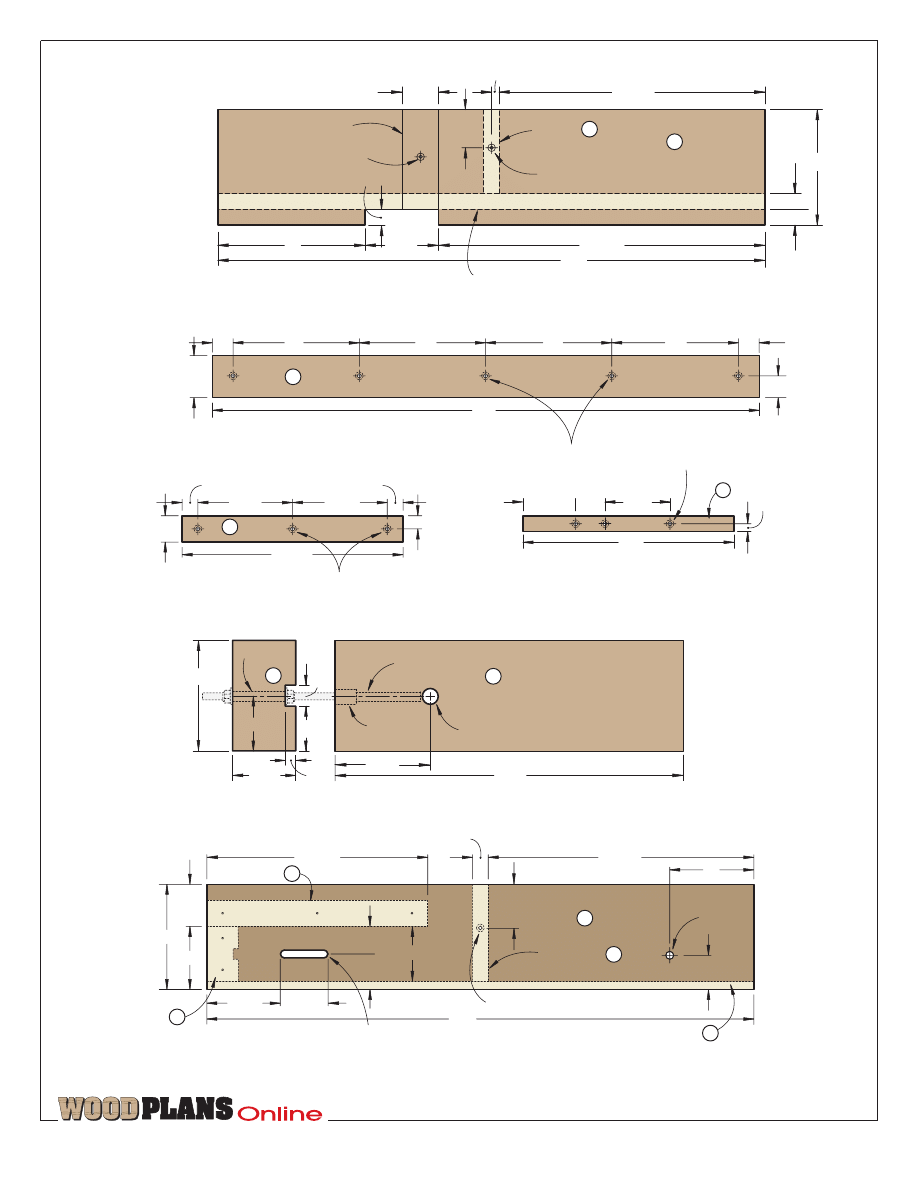
TM
Page 9 of 12
PARTS VIEW
FENCE
12
5
/
8
"
1
3
/
4
"
7"
3
1
/
2
"
26"
3
/
4
"
5
1
/
2
"
2"
3
/
8
"
5
/
32
" hole, countersunk
1
3
/
4
" dado
1
/
4
" deep
*
* groove
3
/
8
" deep along back side of fence
*Actual thickness
of
3
/
4
" plywood
A
*
15
1
/
2
"
7
/
32
" hole, countersunk
5
/
32
" holes, countersunk on bottom side
GUIDE
F
4
1
/
2
"
4
1
/
2
"
5
/
8
"
3
/
4
"
3
/
4
"
10
1
/
2
"
1
1
/
4
"
5
/
32
" holes, countersunk
on bottom side
Note: Size width and thickness to fit
miter-gauge slots on your tablesaw.
MITER-GAUGE GUIDE
26"
2
1
/
8
"
1
1
/
16
"
1"
6"
6"
6"
6"
1"
BASE SUPPORT
10"
2
3
/
4
"
3
/
8
"
D
J
1
1
/
4
"
3
3
/
8
"
1
1
/
2
"
1
/
4
"
ADJUSTMENT
BLOCK
7
/
32
" hole
1"
1
/
2
"
1
1
/
4
"
2
1
/
2
"
G
3
/
8
" hole
9
/
32
" hole
1
/
2
" deep
7
/
32
" hole
2" deep
2
1
/
4
"
H
INDEX SLIDE
5"
7
/
16
" slot 2
1
/
8
" long
26"
5
/
32
" hole, countersunk on bottom
4"
Location of
Location of
BASE
(TOP VIEW)
10
1
/
2
"
3
/
4
"
2
1
/
8
"
2
7
/
8
"
2
1
/
8
"
3
3
/
8
"
2
1
/
2
"
1
1
/
4
"
1
5
/
8
"
2
5
/
8
"
F
12
5
/
8
"
3
/
8
" hole
1
11
/
16
"
Location of G
Location of A
C
E
8
1
/
4
"
Handle location
E
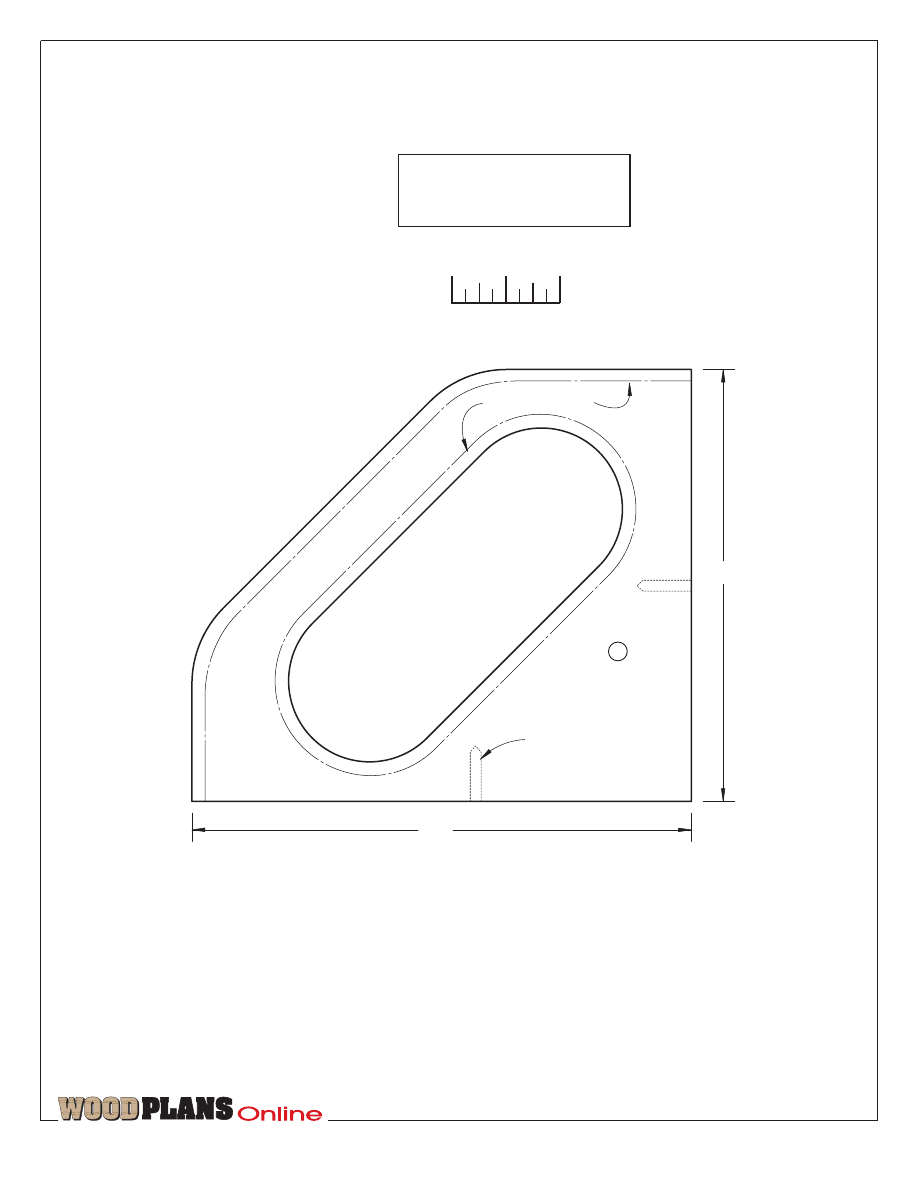
TM
Page 10 of 12
4"
4
5
/
8
"
1
/
8
" round-overs
E
7
/
64
" pilot hole
1
/
2
" deep
HANDLE
To ensure full-size patterns are correct
size, your printer should be set to print
at 100% (not fit to page). Measure
full-size patterns to verify size.
1"
‹
fi
‡
FULL-SIZE HANDLE PATTERN
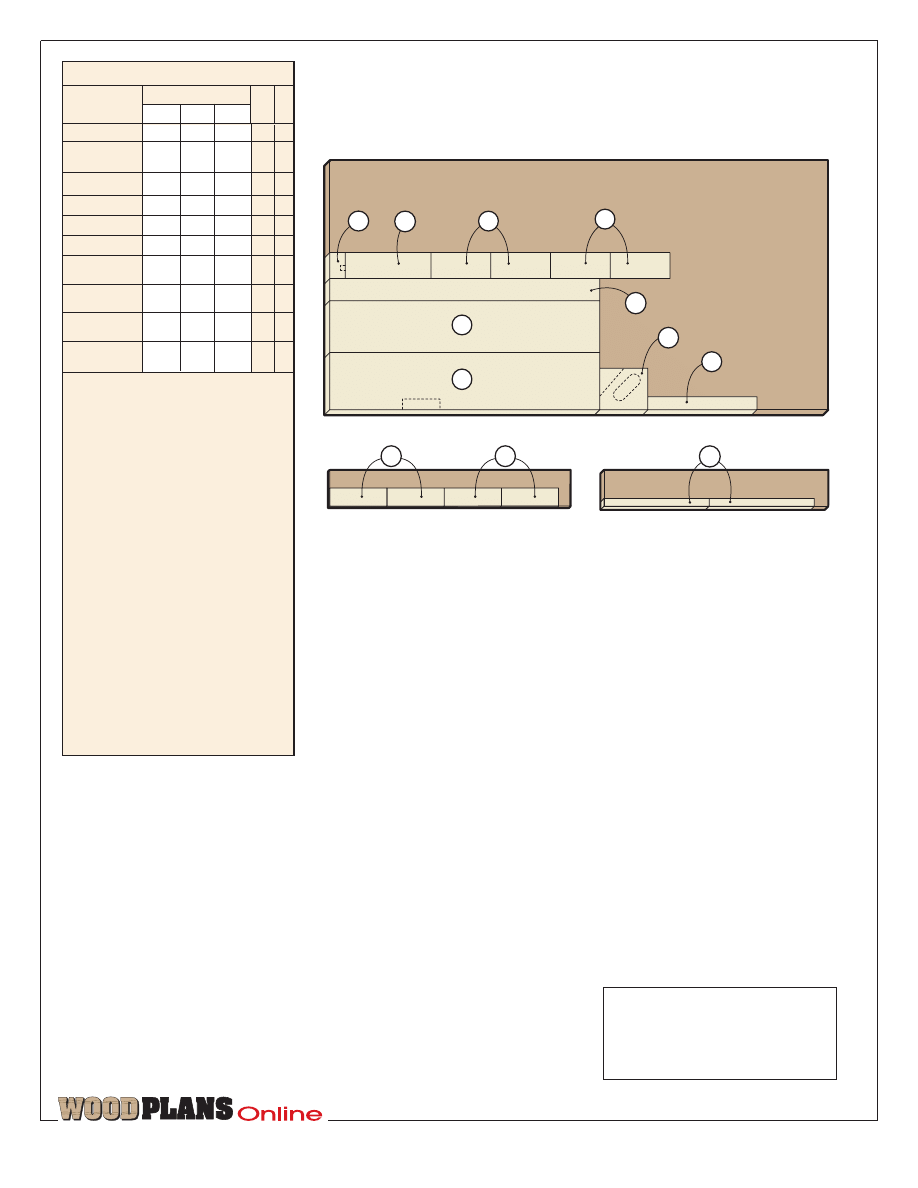
TM
Page 11 of 12
3
/
4
x 24 x 48" Baltic birch plywood
1
/
2
x 3
1
/
2
x 24" Birch
1
/
4
x 3
1
/
2
x 24" Hardboard
CUTTING DIAGRAM
*Plane or resaw to thickness
listed in the Bill of Materials.
F
G
I
I
A
D
E
H
C
*
J
B
B
Part
Bill of Materials
Matl.
Qty
.
T
W
L
Finished Size
A fence
‡"
5fi"
26"
BP
1
B backing
plates
‹"
1‡"
5fi"
HB
4
C base
‡"
5"
26"
BP
1
D support
‡"
2¤"
26"
BP
1
E handle
‡"
4"
4fl"
BP
1
F guide
‡"
1‹"
10fi" BP
1
G adjustment
block
‡"
2fi"
1fi"
BP
1
H index
slide
‡"
2fi"
8‹"
BP
1
I indexing
blocks
‡"
2fi"
5‡"
BP
4
J miter-gauge
guides
›"
‡"
10"
B
2
Materials Key:
BP–birch plywood,
HB–hardboard, B–birch
Supplies:
#8
×
‡" flathead wood screws, #8
×
1‹"
flathead wood screws, ›" carriage bolt 3" long
with a flat washer and plastic knob; 10-32 all-
thread rod 4" long with two locknuts, two flat
washers, 10-32 threaded insert, and mating knob;
›" carriage bolt 4fi" long with a flat washer and
plastic knob; 10-24 flathead machine screw 1"
long with mating flat washer and nut; key stock;
clear finish.
Hardware kit. All the hardware listed in the
Supplies listing
above. WOOD KIT BJJ1, $17.95
plus $3.95 shipping. Schlabaugh and Sons
Woodworking, 720 14th Street, Kalona, IA 52247
or call 800/346-9663 to order.
Easy-to-assemble kit. All the pieces listed in the
hardware kit
above, plus all the Baltic birch
plywood and solid-birch pieces cut to the size
listed in the Bill of Materials. WOOD KIT BJJ2,
$79.95, plus $8.50 shipping. Schlabaugh and
Sons Woodworking, 720 14th Street, Kalona, IA
52247 or call 800/346-9663 to order. Or e-mail at
schsons@kctc.net
Sources
Produced by Marlen Kemmet
Project design: Jan Svec
Graphic design: Lorna Johnson
Illustrations: Kim Downing
Photographs: John Hetherington
©Copyright Meredith Corporation 1998
The purchase of these plans does not
transfer any copyright or other ownership
interest in the plans, the design, or the
finished project to the buyer. Buyer may
neither reproduce the plans for sale nor offer
for sale any copies of the finished project.
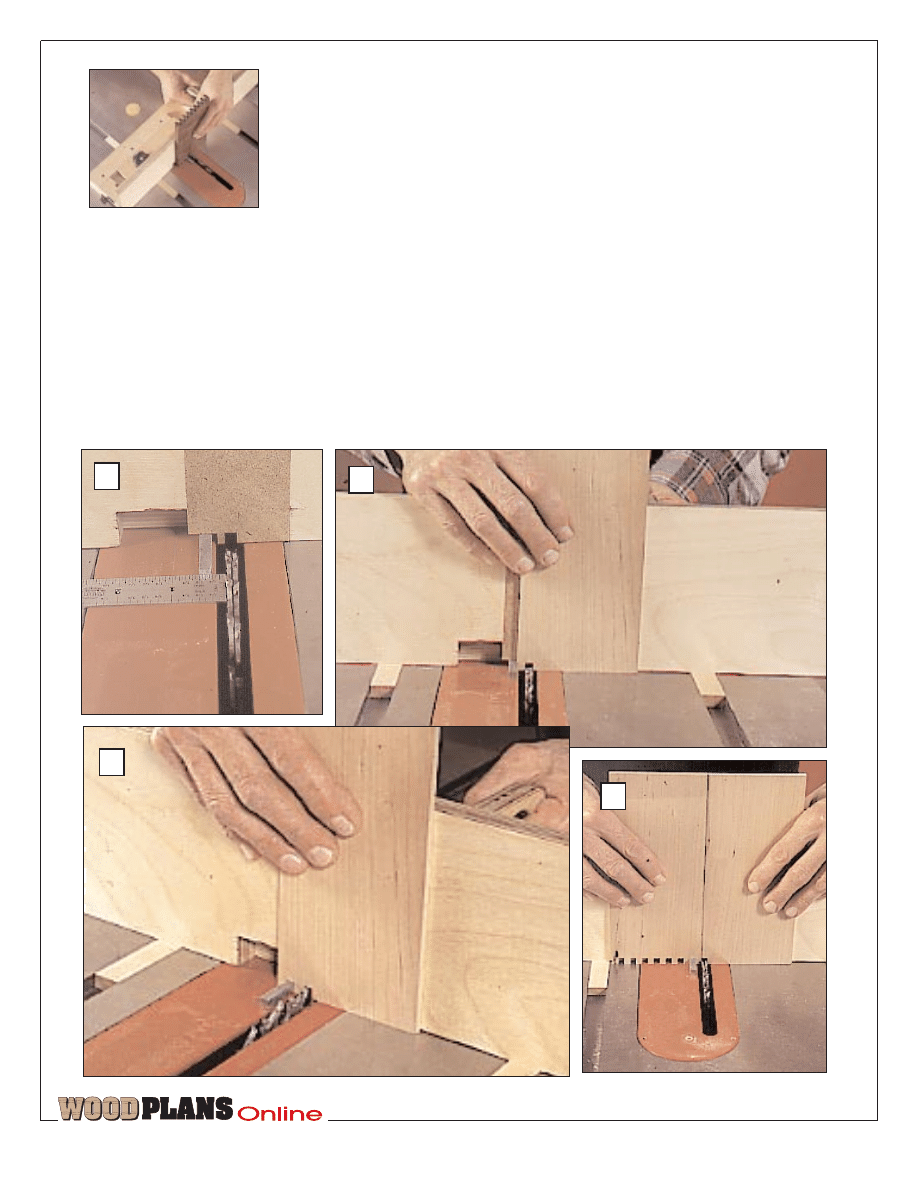
TM
Page 12 of 12
A
D
B
C
Adjust or shim the dado blade to
the same thickness as the wood
being box-jointed. Raise the blade
to the same height as the thickness
of the material being cut plus Î".
As shown in photo A, adjust the
distance between the blade and
indexing pin so the distance is
equal to the width of the blade. It
may be necessary to remove the
backing plate (B), and notch it to
get the pin close enough to the
blade. As shown in photo B, slide
How to make your
box-joint jig do its thing
your stock against the pin, and
make the first cut. Position the
notch just cut onto the index pin,
and make the second cut as shown
in photo C. Repeat until the piece
is completely cut across one end.
For the mating piece, place the
first test piece on the index pin so
just one finger is on the blade side
of the pin. Position the second
piece firmly against the first piece,
and make the cut as shown in
photo D. Remove the first piece,
and make the cuts along the end of
the second piece.
Test-fit the two pieces
together. Chances are you’ll
need to adjust the distance
between the blade and pin. If
the fit is too loose, turn the
knob clockwise to increase the
distance between the pin and
blade. If the fit is too tight, turn
the knob counterclockwise to
decrease the distance.
Test-cut scrap material until the
joints fit perfectly. With the
index pin properly located, lock
the index slide in place with the
large plastic knob.¿
Wyszukiwarka
Podobne podstrony:
ARRL QST Magazine Antennas and Grounds for Apartments (1980) WW
Jig For Mitre Joint Gluing
Jig For Frame And Panel Gluing
(Ebooks) Woodworking Workshop Tips Knife Sharpening Drillpress Jig To Grind Your Own Knives by Am
Lathe Turning Tool Rest and Grinding Jig
[Woodworking Plans] Frame and Panel Assembly Jig SN51P10
JOINT CAPABILITIES INTEGRATION AND DEVELOPMENT SYSTEM
(CRAFTS) Beading russian bead and crochet magazine 1
narrow stock jig
No Quarter Magazine 11 Web Extra Death and Diamonds
Layout Jig
Jig for Router Dadoes
A Content Analysis of Magazine?vertisements from the United States and the Arab World
JOINT CAPABILITIES INTEGRATION AND DEVELOPMENT SYSTEM
więcej podobnych podstron